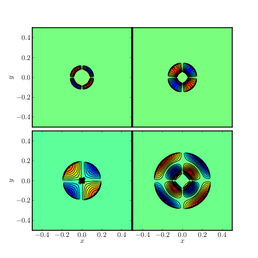High-resolution shock-capturing (HRSC) methods for elastic matter in general relativity
- Started
- 17th June 2010
- Investigators
- Carsten Gundlach, Ian Hawke, Stephanie Erickson
HRSC methods exist for magnetohydrodynamics (MHD) coupled to general relativity, and are being used to investigate strongly magnetised neutron stars (magnetars). HRSC methods for Newtonian relativistic matter (without gravity) also exist in an engineering context. We aim to combine these two technologies, by adding additional variables and equations to GR-MHD HRSC methods.
This requires the development of a mathematical formalism (hyperbolic partial differential equations (PDEs) in conservation law form), the mathematical and physics analysis of its weak solutions, and coding.
Our ultimate aim is the application of this technology to the simulation of neutron stars that are old (a few days after birth) and hence cold enough to have elastic crusts. Of particular interest are oscillations of magnetars, the freezing of the crust shortly after the birth, and the shock melting in the merger of a neutron star binary system.
We will require perfect fluid (or MHD) matter, elastic (magnetised) matter and vacuum (electrodynamics) in the interior, crust and exterior of the stars respectively. We plan to address this through level set methods.
Categories
Physical Systems and Engineering simulation: CFD, Elasticity, General Relativity, Structural dynamics
Algorithms and computational methods: Finite differences, Multi-physics
Transdisciplinary tags: Scientific Computing
